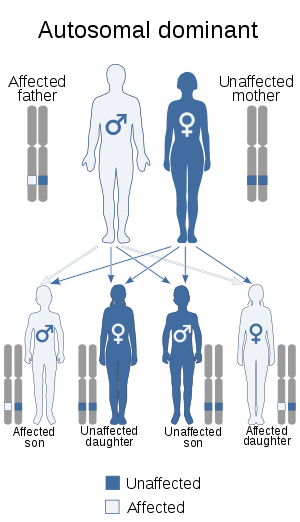Gordon syndrome
| Gordon syndrome | |
|---|---|
| Synonyms | Camptodactyly-cleft palate-clubfoot syndrome |
 | |
| Gordon syndrome is inherited in an autosomal dominant manner | |
Gordon syndrome (GS), or distal arthrogryposis type 3, is a rare, autosomal dominant disorder characterized by cleft palate and congenital contractures of the hands and feet.
Symptoms
Gordon syndrome is an extremely rare disorder that belongs to a group of genetic disorders known as the distal arthrogryposes. These disorders typically involve stiffness and impaired mobility of certain joints of the lower arms and legs (distal extremities) including the knees, elbows, wrists, and/or ankles. These joints tend to be permanently fixed in a bent or flexed position (contractures). Gordon syndrome is characterized by the permanent fixation of several fingers in a flexed position (camptodactyly), abnormal bending inward of the foot (clubfoot or talipes), and, less frequently, incomplete closure of the roof of the mouth (cleft palate). In some cases, additional abnormalities may also be present. The range and severity of symptoms may vary from case to case. Gordon syndrome is inherited as an autosomal dominant trait.
Genetics
While some reports suggest Gordon syndrome may be inherited in an X-linked dominant manner, most agree that it is inherited in an autosomal dominant manner with reduced expressivity and incomplete penetrance in females.
In autosomal dominant inheritance, having only one mutated copy of the disease-causing gene in each cell is sufficient to cause signs and symptoms of the condition. When an individual with an autosomal dominant condition has children, each child has a 50% (1 in 2) risk to inherit the mutated copy of the gene.
If a condition shows variable or reduced expressivity, it means that there can be a range in the nature and severity of signs and symptoms among affected individuals. Incomplete penetrance means that a portion of the individuals who carry the mutated copy of the disease-causing gene will not have any features of the condition.
References
- https://www.rarediseases.org/rare-disease-information/rare-diseases/byID/507/viewAbstract
- Ioan DM, Belengeanu V, Maximilian C, Fryns JP. Distal arthrogryposis with autosomal dominant inheritance and reduced penetrance in females: the Gordon syndrome. Clin Genet. June 1993; 43(6):300-302.
- Gordon syndrome. Orphanet. February 2005; http://www.orpha.net/consor/cgi-bin/OC_Exp.php?lng=EN&Expert=376. Accessed 12/4/2012.
External links
| Classification | |
|---|---|
| External resources |